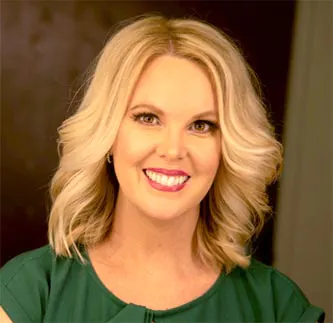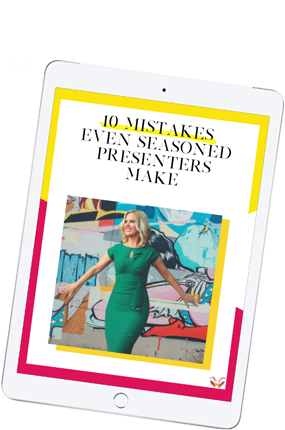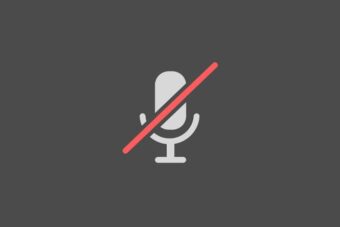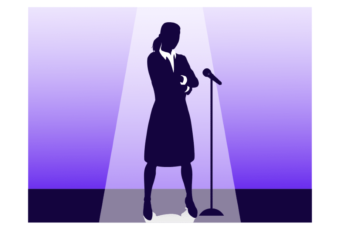Latest Posts
Easy Speaking Tips to Reach Every Audience Member

You ever book that speaking job that you jump for joy, high five yourself and then…. sit back…. and panic?? You haven’t? Oh well, then me either. I just stop at the high five. Eh–hem..
In case you HAVE had that moment I want to give you something that will help you take your presentation skills to the next level in the easiest way possible.
Let’s set the stage:
You are currently a speaker and you stand up in front of the crowd who is excited to see you. You step out onto the stage, speak to the audience and then leave to wild applause. You may have been beyond fantastic, but what if I told you some of your audience didn’t connect? Maybe a handful. Maybe half. Who knows? If you didn’t pay attention to the people in your audience who don’t learn by listening— the kinesthetic learners— or those who learn verbally, then you just walked off the stage, leaving potential fans at bay.
This is your moment to shine, but it’s the audience’s time to to learn, to be inspired and then to do something about it. You want them to take action. You don’t want passive fans, you want to create a movement. This is your moment to make a difference and leave them with some excellent, actionable information.
[Tweet “When you give a talk, strive to creative a movement. Compel your audience to action.”]
How do you do that?
You select 3 key things you want to reinforce and then drive home those three points in every. way. you. can.
The ways you reinforce those key elements is by connecting to them through all of the different ways that your audience learns.
As you know, there are multiple learning styles.
- Aural (Auditory learners)
- Visual
- Physical
- Verbal
- Logical
- Social
- Solitary
There are Too Many!
Yes, I know. After taking a brief look at these, it can be overwhelming to think, How am I going to reach everyone?!!! This means that not everyone learns the same way, and sometimes it’s a combination of more than one of those modalities for someone to really grasp the concept. Yikes.
It’s okay. It’s a lot easier than you think. You are doing some of these already, so don’t be hard on yourself.
So in this article let’s break down the aural and the visual learners. I will also give you suggestions regarding how you can incorporate those into your presentation. (And check back for parts 2 and 3 of this series to discuss the rest of the list.)

Auditory Learners
The Aural one is obviously the easiest one to tackle here, as we are going to presume you’re speaking out loud in this scenario ;). If the audience learns by listening to directions, then you are set. You just need to be clear and concise with what you are saying. This doesn’t mean don’t have personality at all. This means as you explain your points, support them with a story, an example, and anecdote something that will drive the message home along with the directions for what you’re doing.
The best thing for Aural learners is to tell them what they are going to learn, teach them the lesson, support that lesson with an example and then wrap up by going over what they just learned. Aural learning doesn’t mean that they hear it once and then they got it, it means that they thrive in learning by listening. So give the auditory learners a variety of ways to hear the same message to increase their understanding,
[Tweet “Aural learning doesn’t mean that they hear it once and then they got it, it means that they thrive in learning by listening.”]
Aural Learning In Practice
Let’s say you are talking about a new App that will help organize social media. You will start by letting your audience in on what’s coming, the details, the example and a refresher:
“Today, [WHAT THEY WILL LEARN] I am going to tell you about this new incredible social media app that will change your life and cut your online time in half. [THE DETAILS] Here is the app and all the amazing things it can do. [THE EXAMPLE & STORY] When I say it will change your life, I mean it. It has saved my family life. Seriously. Before this app, I spent hours every night just trying to keep up with building my business and offering customer service to my very social clients. My life was work, all the time. This is how it improved it. Now, I can get the same results by spending less time. I have more time to spend with my family, to play with my kids and not push them off, because I had to make sure my customers were getting timely responses. [IN SUMMARY] So to wrap things up the app is ___ and we learned how to implement it and how to automate our social media so now that second child my husbands been asking for may just happen.”
Now some presenters stop right there. They have told compelling stories, made the audience laugh, got everyone excited about potentially taking that long-overdue vacation and starting a family. But I know you’re different. You don’t want to stop there. You want to continue reaching not just the aural learners, but others too.

Visual Learners
The next set of learners is the Visual learners. Luckily for you, this is also a very attainable thing for speakers. You put up a PowerPoint, and you are half way there.
The mistake that a lot of presenters make is that they put EVERYTHING on that PowerPoint. Every word that they are saying, every idea they have is fills that page from margin to margin. For visual learners that is detrimental! It becomes overwhelming, and they don’t know what to focus on. They start reading the bullet points, trying to make sense out of it all—but without the navigation of what they really need to focus on. And if they are reading, they aren’t listening to you.
My advice to you is Edit. Edit. Edit. This isn’t the moment to take everything you know and put it into one presentation. Rule of thumb: if you are using text, no more than 3-4 bullet points per page.
But guess what? Visual learners learn through imagery as well, they learn from videos, they learn from seeing your body language. They take in all of the visual cues you are putting out there to communicate to them and they absorb it all to get to an understanding that you need to drive.
[Tweet “Visual learners learn through imagery, videos, body language, all visual cues that you put out there.”]
Visual Learning in Practice
So as you’re talking about the app that saves you time, your imagery can provide connection to your words without being an exact duplicate of them, like a picture of someone overworked and stressed. You can put words that intentionally pile onto the slide, overwhelming the slide to show that social media could bury you. Then you show the app, do a demo of the app and then move on to pictures of your family, your husband and a kid’s little league team. You show a video of you watching your son run the bases and cheering him on as he hits home plate.
Your images have matched in step with your aural queues. You now have told the story visually for your visual learners with a variety of paths, not just text on a screen.
As you can see, when you start concentrating on the different learning modes, your presentations will start coming to life.
If you want to learn more about how you can incorporate the others into your presentation, add your email to our list (form below) and we will make sure the next parts of this series will be in your inbox!

Hi, I'm Misty Megia!
I’m a Creative Director for high-achieving leaders who want to unmute themselves to give presentations that move people profoundly through my Corporate Speaking Program and my Theatre of Public Speaking Program.
Discover the
10 mistakes
even seasoned presenters make!

Work
With Me
Corporate Speaking Program
Your team’s success depends on their ability to speak with clarity. Give them the tools to meet the moment with professionalism.
Theatre of Public Speaking Program
Take my 6-week on-demand course with live group coaching to deliver big messages that motivate and inspire.



